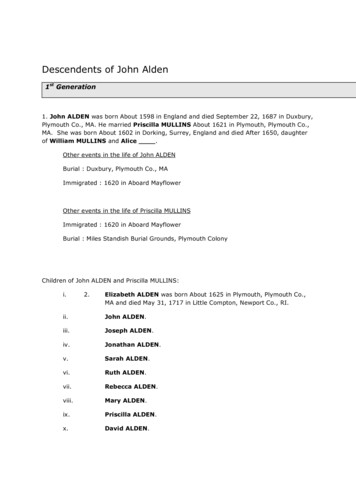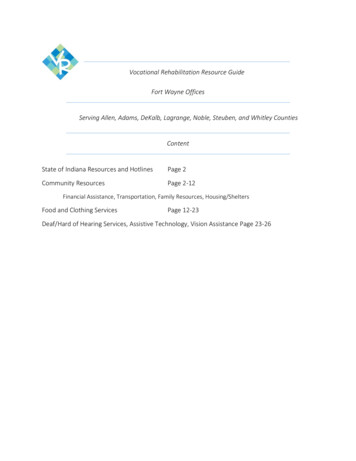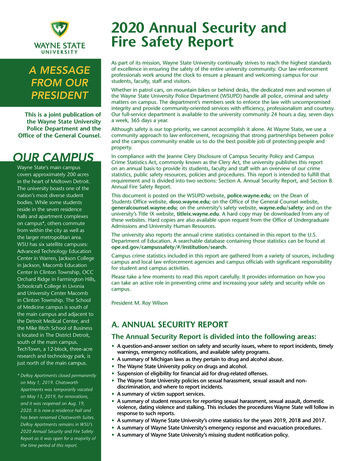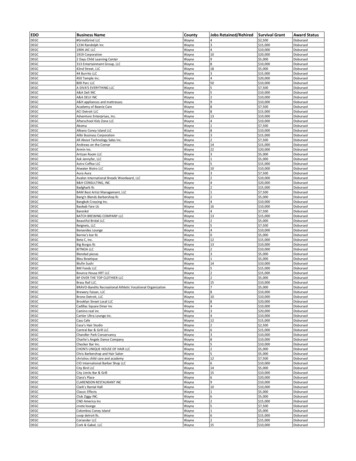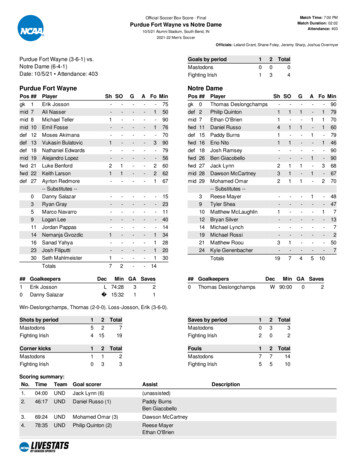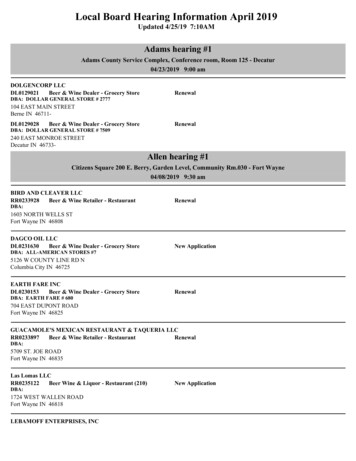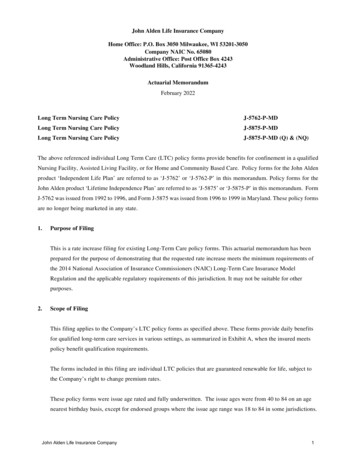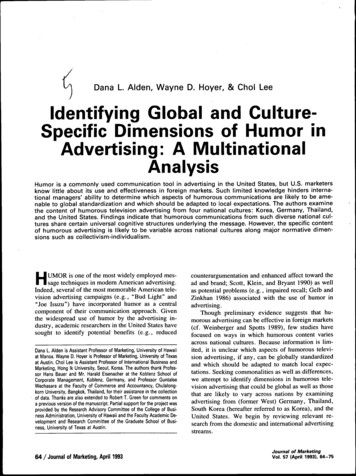
Transcription
Dana L Alden, Wayne D. Hoyer, & Choi LeeIdentifying Global and CultureSpecific Dimensions of Humor inAdvertising: A MultinationalAnalysisHumor is a commonly used communication tool in advertising in the United States, but U.S. marketersknow little about its use and effectiveness in foreign markets. Such limited knowledge hinders international managers' ability to determine which aspects of humorous communications are likely to be amenable to global standardization and which should be adapted to local expectations. The authors examinethe content of humorous television advertising from four national cultures: Korea, Germany, Thailand,and the United States. Findings indicate that humorous communications from such diverse national cultures share certain universal cognitive structures underlying the message. However, the specific contentof humorous advertising is likely to be variable across national cultures along major normative dimensions such as collectivism-individualism.HUMOR is one of the most widely employed message techniques in modem American advertising.Indeed, several of the most memorable American television advertising campaigns (e.g., "Bud Light" and"Joe Isuzu") have incorporated humor as a centralcomponent of their communication approach. Giventhe widespread use of humor by the advertising industry, academic researchers in the United States havesought to identify potential benefits (e.g., reducedDana L. Alden is Assistant Professor of Marketing, University of Hawaiiat Manoa. Wayne D. Hoyer is Professor of Marketing, University of Texasat Austin. Choi Lee is Assistant Professor of International Business andMarketing, Hong Ik University, Seoul, Korea. The authors thank Professor Hans Bauer and Mr. Harald Eisenacher at the Koblenz School ofCorporate Management, Koblenz, Germany, and Professor GuntaleeWechasara at the Faculty of Commerce and Accountancy, Chulalongkorn University, Bangkok, Thailand, for their assistance in the collectionof data. Thanks are also extended to Robert T. Green for comments ona previous version of the manuscript. Partial support for the project wasprovided by the Research Advisory Committee of the College of Business Administration, University of Hawaii and the Faculty Academic Development and Research Committee of the Graduate School of Business, University of Texas at Austin.64 / Journal of Marketing, April 1993counterargumentation and enhanced affect toward thead and brand; Scott, Klein, and Bryant 1990) as wellas potential problems (e.g., impaired recall; Gelb andZinkhan 1986) associated with the use of humor inadvertising.Though preliminary evidence suggests that humorous advertising can be effective in foreign markets(cf. Weinberger and Spotts 1989), few studies havefocused on ways in which humorous content variesacross national cultures. Because information is limited, it is unclear which aspects of humorous television advertising, if any, can be globally standardizedand which should be adapted to match local expectations. Seeking commonalities as well as differences,we attempt to identify dimensions in humorous television advertising that could be global as well as thosethat are likely to vary across nations by examiningadvertising from (former West) Germany, Thailand,South Korea (hereafter referred to as Korea), and theUnited States. We begin by reviewing relevant research from the domestic and international advertisingstreams.Journal of MarketingVol. 57 (April 1993), 64-75
The Advertising Research Streamon HumorDomestic ResearchCommunication managers in the United States havegenerally assumed that humor enhances advertising'seffectiveness (Madden and Weinberger 1984). To determine whether this assumption is true and, if so, why,advertising research in the U.S. has centered on threetopics: (1) analysis of humor effects on recall, evaluation, and purchase intention (cf. Zhang and Zinkhan 1991), (2) study of mediating factors such as repetition of the ad (Gelb and Zinkhan 1985), social settingin which the ad is viewed or heard (Zinkhan and Gelb1990), and prior attitude toward the brand (Chattopadhyay and Basu 1989), and (3) examination ofwhether humor influences consumers more throughcognitive processes such as enhanced recall (Zhangand Zinkhan 1991) and reduced counterargumentation(Gelb and Zinkhan 1986) or through affective mechanisms such as transfer of liking for the ad to the brand(Aaker, Stayman, and Hagerty 1986; Zinkhan and Gelb1990).One overall conclusion drawn from these streamsis that humor is more likely to enhance recall, evaluation, and purchase intention when the humorousmessage coincides with ad objectives, is well-integrated with those objectives, and is viewed as appropriate for the product category. Under such circumstances, humorous advertising is more likely to "secureaudience attention, increase memorability, overcomesales resistance, and enhance message persuasiveness" (Scott, Klein, and Bryant 1990, p. 498; see alsoKrishnan and Chakravarti 1990).Cross-National ResearchSeveral cross-national studies of international advertising in general have been undertaken. For example,researchers have examined print and television advertising from various national markets for similarities and differences in (1) levels and types of information (Dowling 1980; Hong, Muderrisoglu, andZinkhan 1987; Madden, Caballero, and Matsukubo1986), (2) reflection of cultural attitudes toward consumption (Mueller 1987; Tse, Belk, and Zhou 1989),and (3) portrayal of sex roles (Gilly 1988). With theexception of Tse, Belk and Zhou (1989), whose sample did not include U.S. ads, these researchers foundsignificant differences between U.S. and foreign advertising on key variables of interest.Other researchers have documented ways in whichmultinational firms attempt to globally standardize advertising. For instance, Peebles, Ryans, and Vemon(1978) distinguish between firms' use of "prototype"standardization (same ad with only translation andnecessary idiomatic changes) and "pattern" standardization in which the overall campaign is designed (e.g.,theme) for application in several national markets withsome adaptation of content and execution (Walters1986). Killough (1978) differentiates between "buying proposals" that state the basic offer and "creativepresentations" that package the buying proposal. Onthe basis of reports from senior executives involvedin more than 120 multinational campaigns, Killoughconcludes that buying proposals can be used successfully across cultures without modification more oftenthan creative presentations, which tend to interact withlocal cultural factors (see also Onkvisit and Shaw 1987).Though such issues have been examined in a crossnational context, only one study appears to have lookedat the use of humor in advertising within other national markets. Comparing television advertising inthe U.S. and the U.K., Weinberger and Spotts (1989,p. 39) report that a significantly greater percentage ofads in the U.K. (35.5% vs. 24.4%) were characterized by humorous intent. In both countries, humor wasemployed most often with "low involvement/feelingproducts" and least often with "high involvement/feeling" products. Knowledge of such differences isclearly important. However, another dimension yet tobe examined may serve as a construct common to humorous advertising in multiple national markets. Thatdimension is the potential similarity in the cognitivestructures underlying humorous television advertisingfrom around the world.Meyers-Levy and Tybout (1989) demonstrate theusefulness of the cognitive structure approach in a domestic consumer behavior context. They examined theevaluative effects of moderate differences or "incongruities" between new product information and information for the overall product category cued frommemory. They report that moderate incongruity fromexpectations produced more favorable evaluations ofnew product information than did congruity or extreme incongruity. As they note, "the very process ofresolving the incongruity is thought to be rewardingand thus may contribute to the resulting positive affect" (p. 40; see also Mandler 1982).Cognitive principles similar to those described byMeyers-Levy and Tybout seem likely to be involvedin the structures and processing of humorous advertisements. More specifically, Meyers-Levy and Tybout's results appear to parallel those that would bepredicted by theories from psychology and linguistics.These theories specify incongruity and incongruityresolution as central to generating the positive affectthat often accompanies humor (cf. Herzog and Larwin1988). For example, Raskin's (1985, p. I l l ) theoryof humor argues that jokes often produce a mirthfulresponse by including cognitive, structural contrastsbetween expected and unexpected situations (e.g., inHumor in Advertising / 65
the Bud Light beer commercial, the character arrivingwith a flashlight versus the other character exclaiming, "I said Bud Light!").Structural analysis of humorous advertising fromseveral national cultures could help determine whethercognitive principles such as those hypothesized byRaskin are global or culture-speciflc. To explore potential applications of these theories to cross-nationalanalysis of humorous advertising, we now turn to thepsychological and linguistic literature on humor.Psychological and LinguisticPerspectives on HumorA major school of humor has focused on the cognitivestructures and processing pathways that are central toa humorous response (Herzog and Larwin 1988). Keyto such theories is the notion of incongruity or deviation from expectations. One group of theorists arguesthat incongruity is a necessary and sufficient conditionto produce humor (Suls 1983). In line with this position, Nerhardt (1970) found that the greater the unexpected deviation from normally expected occurrences, the greater the humor response. A second grouphypothesizes that incongruity alone is not always sufficient to produce a humor response. Rather, "according to this account, humor results when incongruity is resolved; that is, the punch line is seen tomake sense at some level with the earlier informationin the joke" (Suls 1983, p. 42). A key tenet of thisschool is that humor is a form of problem solving, asincongruity without resolution leaves listeners confused or frustrated because they do not "get the joke."Not all problem solving, however, is humorous.Incongruity-resolution theorists suggest that a humorous response depends on (1) rapid resolution of theincongruity, (2) a "playful" context, that is, with cuessignifying that the information is not to be taken seriously, and (3) an appropriate mood for the listener(Suls 1983). Support for this position has been provided by several studies of different humorous stimuli(cf. Herzog and Larwin 1988; Oppliger and Sherblom1988; Wicker et al. 1981). Suls (1983) concludes thatboth incongruity and incongruity-resolution styles ofhumor exist, but that the latter predominates, particularly for verbal humor. In addition, even researcherswho advocate greater integration of motivational andcognitive models of humor acknowledge a central rolefor incongruity theory within their proposed framework (cf. Kuhlman 1985).From a linguistics perspective, Raskin (1985) suggests a script-based semantic theory, "a linguistic theory which interposes a cognitive step in the perceptionof what's funny" (MacHovec 1988, p. 92). This theory states that a verbal or written communication isconsidered a joke when the "text . . . is compatible66 / Journal of Marketing, April 1993fully with two distinct scripts and the two scripts areopposite in certain definite ways such as good-bad,sex-no sex, or real-unreal." The third element, thepunchline, "switches the listener from one script toanother creating the joke" (Raskin 1985, p. 34-35).More often than not, according to Raskin, the humorous scripts will be opposite in terms of a "real"and an "unreal" situation. For example, consider thefollowing joke (Raskin 1985, p. 106).An English bishop received the following note fromthe vicar of a village in his diocese: "My lord, I regret to inform you of my wife's death. Can you possibly send me a substitute for the weekend?"Here, the joke initially evokes the real situation ofa vicar wanting a substitute vicar because his wife hasjust died. The unreal script involves a vicar wantinga substitute wife. In addition, there is a playful oppositeness in the two scripts on which the humor turns.That opposition involves the contrast between the expected "piousness" of a religious figure and the unexpected implied sexual interaction between the vicarand his "substitute" wife. Following the incongruityresolution model, one can hypothesize that the incongruity of a vicar seeking a substitute "wife" is resolved with the realization that the vicar undoubtedlymeans one thing but has inadvertently implied another.According to Raskin, contrasts such as these canbe more finely categorized as (1) actual/existing andnonactual/nonexisting, (2) normal/expected and abnormal/unexpected, and (3) possible/plausible andfully/partially impossible or much less plausible. Forthe first subtype, consider the preceding joke. Here,it is actually the case that the vicar wants a substitutefor himself, but it is not actually the case that the vicarwants a substitute for his wife. Thus the humorouscontrast involves actual versus nonactual. An exampleof an expected/unexpected contrast is seen in the following joke.A doctor tells a man, "Your wife must have absoluterest. Here is a sleeping tablet." "When do I give itto her?", the man asks. "You don't," explains thedoctor, "you take it yourself."In this case, the contrast involves the normal orexpected action of a doctor prescribing medication foran ill person versus the abnormal or unexpected prescription for the healthy but talkative spouse. Playfulness in the joke is captured in the contrast betweenthe expected care-giver role and the unexpected irritation-inducing role of the spouse.The third contrast specified by Raskin involves apossible or plausible versus an impossible or muchless plausible situation. For example (p. 47):Samson was so strong, he could lift himself by hishair three feet off the ground.
Though it seems likely that Samson was strong enoughto lift another person off the ground, it would be impossible for him to lift himself off the ground.Raskin's theory can be interpreted within the incongruity-resolution school of humor. First, as withincongruity-resolution theory, Raskin's theory positsa switch from "bona-fide" communication to a playful, nonthreatening mode (p. 140). Incongruity is thenestablished by the presence of two partially or fullycontrasting scripts that are compatible with the text,as discussed previously (i.e., possible/impossible, etc.).Finally, a "trigger, obvious or implied" (e.g., apunchline), helps the listener or reader resolve the incongruity by fully realizing the oppositeness of thesituation. Thus, from the incongruity-resolution school,Raskin's theory can be supplemented with the hypothesis that the sudden realization of oppositenessquickly reduces the listener's felt tension and decreases "arousal back to base-line," creating pleasurein the process (Suls 1983, p. 44).Raskin's script-based humor theory along with incongruity and incongruity-resolution theories couldprove helpful to understanding cognitive structures thatmay characterize humorous advertising around theworld. Though developed for verbal humor, Raskin'sscript-based semantic theory may well predict the typesof incongruent contrasts one is likely to find in humorous advertising, whether verbal or visual.Application of Humor Theory in aCross-National ContextCognitive factors underlying humorous communication in the U.S. may also be found in humorous advertising from other national markets. For example,cross-cultural researchers report evidence suggestinguniversal use of cognitive categories and summaryrepresentations for storage and application of the continuous stream of information to which human beingsare exposed (e.g. Pick 1980; Rosch 1977). Globaluse of such structures supports a central assumptionof the incongruity school of humor—that people develop expectations based on category norms that arecapable of being violated, sometimes in a humorousfashion.Within the humor stream itself, several scholarsconclude that humor is indeed universal and that incongruity is one of its central cognitive-structuralprinciples. Fry (1987, p. 68) notes that humor was apart of life in dynastic Egypt and that "contemporaryrecords in the Old Testament speak of laughter, joy,and amusement." As Berger (1987, p. 6) states:Humor is . . . all pervasive; we don't know of anyculture where people don't have a sense of humor,and in contemporary societies, it is found everywhere—in film, on television, in books and newspapers, in our conversations, and in graffiti.Similarly, anthropologists have found that "jokingrelationships" involving "joking, teasing, banter, ridicule, insult, horseplay, usually, but not always, involving an audience" are present in both traditionaland more industrialized societies (Apte 1983, p. 185).From the Amba people of southern Africa (Apte 1983)to machine operators in the United States (Fine 1983),such joking relationships appear to be commonplace.Joking behavior has even been observed in primates(Fry 1987).Furthermore, "incongruent, outrageous or deviantmanifestations of personalities, behavior and so forth,are also important in such joking activities" (Apte 1983,p. 186). For example, evidence for the universal importance of incongruity in humor is found in "contrarybehavior" (e.g., "sitting on animals backwards whileriding"), which has been reported to be a major component of ritual humor among American Indians,tribespeople in Africa, and villagers in India (Apte1983, p. 190). Suls (1983) takes the argument a stepfurther when he states that most humor around the worldhas an incongruity-resolution structure. As evidence,he cites Shultz (1972), who examined verbal humorin the folklore literature of non-Western societies, andreports (p. 47):The presence of incongruity and resolution featureswas found in the vast majority of materials (for example, of 242 Chinese jokes examined, 210 possessed incongruity and resolution).Hypotheses 1 and 2: GlobalPrinciplesThe foregoing review suggests that humor is universal. Furthermore, the cognitive-structural characteristic, incongruity, appears likely to be present in muchof the humor around the world. Hence, incongruitymay well be a major global component of humorousadvertising. Though Raskin's (1985) theory does notspecify whether the frequencies of his three hypothesized contrasts vary by national culture (i.e., whetherculture A's humor will emphasize expected/unexpected contrasts whereas culture B's will emphasizereal/unreal), it appears to predict that the contrastswill be discernible in a given national culture's humorin some proportion. On the basis of this theory, wepropose our first hypothesis.H]! Most television advertising from diverse national markets in which humor is intended exhibits incongruentcontrasts.In addition to establishing the presence of incongruity in humorous advertising, a goal of our study isto identify specific types of contrasts. If these contrasts can be identified, researchers and practitionerswill better understand which aspects of the ad can bestandardized and how such standardization can occur.Humor in Advertising / 67
For example, finding that none of the humorous adsfrom several national markets employ Raskin's possible/impossible contrast would suggest that this formof incongruity may not work well in global advertising campaigns that intend to be humorous. In contrast,if Raskin's theory is to be relevant to international advertisers, one or more of the contrasts it predicts (i.e.,actual/nonactual, expected/unexpected, and possible/impossible) should be identifiable in substantialnumbers in television advertising from several diversenational markets. Our second hypothesis proposes thatthe three specific contrasts predicted by Raskin areidentifiable in television advertising from differentmarkets.H2: Across diverse national markets, three specific typesof contrasts (actual/not actual, expected/unexpected,and possible/impossible) are identifiable in televisionadvertising that is intended to be humorous.Though we expect national markets to differ in theproportion of humor ads that stress one or more of thethree types of contrasts, there is little prior theory onwhich to base any related predictions. Therefore, ourinvestigation of differences in the relative use of thespecific contrasts is exploratory.tures. Individualist cultures, in contrast, tend to becharacterized by multiple in-groups that are smallerand less demanding of their members. Reflecting thesedifferences, intended humor ads from cultures high incollectivism (e.g., Thailand and Korea) should involve larger groups of relatively close associateswhereas those from cultures low in collectivism (e.g.,Germany and the U.S.) should involve smaller groupsor no group at all. Therefore, we hypothesize:H3: The number of individuals or characters playing majorroles in ads in which humor is intended is greater inhigh collectivism (low individualism) cultures than inlow collectivism (high individualism) cultures.Hofstede's second dimension, power distance, involves the extent to which power within a nationalculture is unequally distributed (Ronen 1986). National cultures high on power distance tend to be hierarchic in their interpersonal relationships and decisionmaking whereas those low on power distance tend tobe more egalitarian. Advertising should differ on thisdimension, with high power distance cultures exhibiting more relationships between characters that areunequal and low power distance cultures exhibitingmore relationships that are equal. Our fourth hypothesis follows.Hypotheses 3 and 4: CultureSpecific DifferencesAs McCracken (1986, p. 75) notes, "advertising is aconduit through which meaning constantly pours fromthe culturally constituted world to consumer goods."As a result, an important goal of advertising is to bringthe cultural world and the good together in a "specialharmony" that enables the viewer to see "this similarity and effect the transfer of meaningful properties"(McCracken 1986, p. 75). Because the "content ofads mirrors a society" (Tse, Belk, and Zhou 1989),one would expect actual message content (versus theunderlying structure) to reflect the culture in which itappears. Hence, despite possible similarities in humorous structures and principles across national cultures, significant differences seem likely to be foundin the situations, settings, and themes used to conveyhumor. Furthermore, such differences seem likely toreflect major national culture distinctions such as thosedocumented both in previous advertising research (e.g.,Gilly 1988; Mueller 1987; Tse, Belk, and Zhou 1989)and nonadvertising research (e.g., Hofstede 1983).Hofstede (1983), for example, found that nationalcultures could be differentiated on several dimensions. Two of the dimensions he identified were"individualism-collectivism" and "power distance."Looking at the first dimension, Triandis et al. (1988)note that subordination of individual goals to the goalsof a few large in-groups is central to collectivist cul-68 / Journal of Marketing, April 1993H4: Relationships between central characters in ads in whichhumor is intended are more often unequal in high powerdistance cultures than in low power distance cultures,in which these relationships are more often equal.MethodSampling National CulturesTo improve reliability while enhancing generalizability, we chose two sets of countries that had similarcharacteristics within each set but differed between setson several important dimensions. The United Statesand Germany made up the first set. These nations aresimilar inasmuch as both are Western, developed nations having high scores on Hofstede's (1983) individualism-collectivism dimension (i.e., low on collectivism) and low scores on the power distancedimension (see Table 1). The second set, Korea andThailand, are similar to each other yet different fromthe first set inasmuch as both are Asian, rapidly developing nations having high scores on collectivismand high scores on power distance. Though hypothesized cognitive-structure principles (H, and H2) werepredicted to hold across all four nations, the contentof humorous advertising was expected to differ between the matched pairs of nations on Hofstede's individualism and power distance dimensions (H3 andH4).
TABLE 1Scores and Ranks of Countries on Collectivismand Power Distance Dimensions'Power DistanceUnited 311 Based on Hofstede (1983)."Rank is based on 50 countries in sample; for example, U.S.is 16th from the lowest on power distance and Thailand is 31stfrom the lowest. Germany is 6th highest on individualism butonly 14th on collectivism whereas Korea is the 11th highest onindividualism but 39th from the lowest on collectivism.Sampling Ads Within CountryRandomized cluster samples of national brand TV adsshown on major networks in each country were collected. Local advertising and duplications of nationalbrand ads were eliminated along with ads that contained more than 50% sales promotion information(e.g., a tie-in promotional ad for Pepsi with a localsupermarket). Ads for the same brand that differed in50% or more of the content remained in the sample.As other sampling plan details varied slightly amongcountries, we describe each plan.Sampling in the U.S. was conducted over threedays in early November 1990. On each day (randomlychosen), one of the three major privately owned national networks (randomly assigned to each day) wasrecorded (6 a.m. to midnight). All ads were thenlogged. We obtained a total of 497 unduplicated adsfor national brands from the three major Americannetworks. In Thailand and Korea, a similar procedurewas followed. However, in those countries, the tapesand master lists of cluster-sampled ads (three days fromthree stations with days randomly selected) were obtained from market research firms that monitored TVand radio advertising. Also in both countries, one ormore government-owned stations that carried ads fornational brands were included. In Thailand, ads wererecorded during April 1990, resulting in 351 unduplicated ads. In Korea, recording was done duringFebruary 1990, resulting in 520 unduplicated ads.Finally, in Germany, the two major national television channels are strongly regulated by the government (Clemens 1987). As a result, advertising on thesechannels is very limited in terms of frequency andcontent. With the advent of cable television, however,German viewers are now exposed to a wider varietyof programming options and advertising (Clemens1987). Therefore, to provide a representative sampleof German advertising, three privately owned and operated channels that carry ads for national brands weresampled over a three-day period during October 1990.As in the United States, a log of all advertising wascreated. Duplicates, promotional ads, and local brandads were eliminated, leaving a total of 244 ads foranalysis.Humorous Ad IdentificationThree native, bilingual coders in Germany and fourin each of the other countries were instructed in theirown language and in English on how to rate ads interms of humor. Following Weinberger and Spotts(1989, p. 40), we did not ask judges to determinewhether they personally felt the ad was humorous; instead, the humorous intent of the ad was coded in aneffort to reduce subjectivity. In other words, becausecertain ads seem likely to appeal more to specific segments of the culture than to others, coders did notjudge how funny each ad was, but only whether humor was intended.An ad was assumed to contain intended humor whenat least three coders agreed. In all countries, interjudge agreement (calculated as the percentage of threeor more agreements that humor either was or was notintended) exceeded 80% (cf. Sujan 1985). In the U.S.,80 ads were judged by three of four coders to containintended humor. In Germany 48 ads and in both Thailand and Korea 51 ads were judged by three or morecoders to contain intended humor. To reduce the subsequent in-depth coding task for the U.S. sample, onlyads on which all four coders agreed were used, resulting in 52 ads for analysis.In-Depth Coding ProceduresThree new native coders used a standard coding formto evaluate intended humor ads in each country. Allcoders received extensive training prior to the actualcoding task. Much of this training was conducted inthe coders' native languages, though foreign researchers were usually present. Originally written in English, coding forms were subsequently double backtranslated to assure maximal equivalency, except inGermany where the coders' high English proficiencyallowed use of the original forms. Each intended humor ad was viewed two to three times and coders thenindependently evaluated the ad. Subsequent viewingwas allowed when coders had questions about the ad'scontent, style, or some other aspect. The coding formstook 10 to 15 minutes to complete for each ad. Forall items in all country samples, interjudge agreementexceeded 85%. Disagreements were resolved amongthe coders without the involvement of the investigators beyond simple clarification of coding guidelines.MeasuresFirst, coders were asked to indicate (yes/no) whetherthe ad contained any of the contrasts such as thoseHumor in Advertising / 69
specified by Raskin (1985)—actual/nonactual, expected/unexpected, or possible/fully or partially impossible. Second, coders were asked to determine whichspecific contrasts were present in the ad. In addi
Dana L Alden, Wayne D. Hoyer, & Choi Lee Identifying Global and Culture-Specific Dimensions of Humor in Advertising: A Multinational Analysis Humor is a commonly used communication tool in advertising in the United States, but U.S. marketers know little about its use and effectiveness in foreign markets. Such limited knowledge hinders interna-


